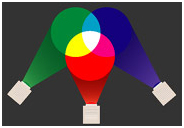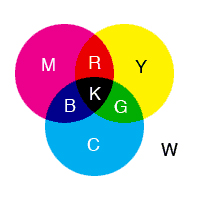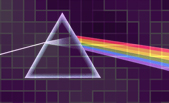Color and light are natural phenomenons that we usually take for granted. There is much scientific theory about both. An understanding of the basic concepts of light and color are essential to the designer, printer or photographer. This understanding is necessary to fully understand the principles of both designing with color and the reproduction of color.
Additive Color
First things first about additive color, or any color for that matter. In order to perceive color, there must be light first. Light is made up of wavelengths created by energy. The wavelengths themselves are not colored, but instead they produce the sensation of color. The human eye can only detect a very small portion of the spectrum of light. In that visible spectrum, we perceive the shortest wavelengths as blue and the longest ones as red. All other colors fall in between those two.
First described by James Clark Maxwell in the mid 1800s, the color additive theory describes how we perceive color and how colors are created. The white light of daylight actually consists of many different colors. Wavelengths within this light are organized into "bands". We label these "bands" of color with names. Color names are called "hues" (blue, green, red etc).
When equal parts of each of the three major color bands are combined together, you see white light. White light is the sum of red, green and blue. This is "additive color". The absence of all three bands will produce black.
Therefore, the primary colors in additive color theory are red, green and blue. Primary colors are colors that can not be created from any other color. Color models built using the additive primaries are referred to as "RGB", an acronym for red, green and blue.
"RGB" color models are used in television screens and computer monitors. They display color by using the additive color system. Also, digital cameras and scanners capture color by using the same principles.

Creating Additional Colors
To understand how RGB colors or wavelengths combine to form other colors, think of each of the primary colors as a spot light or circle. When red and green overlap, yellow is created. The overlap of green and red creates yellow, and magenta is created by the overlap of red and blue.
 
Remember, in discussing additive color, it's the combination of light waves, not actual paints or pigments, that creates color. When working with paints or pigments, the primary colors red, blue and yellow combine to create violet, orange and green and all the shades in between.
Secondary Colors
Combining equal parts of each of the primary colors creates the secondary colors. The three secondary colors are cyan, magenta and yellow. While producing color with a combination of primary colors is known as additive color, using combinations of the secondary colors is called the "subtractive" color system.
Subtractive Color
Subtractive color is what happens when you mix paint or print a full-color image on a printing press. This is the type of color mixing most people are familiar with. "Yellow plus blue equals green" is a subtractive color mixture, but actually it's "yellow plus cyan equals green".

Subtractive color, as its name implies, subtracts color when mixed. In the diagram above you can see that each mixed color (R, G, B, and K) is darker than any of the primary colors (C, M, and Y). Every time a color is added less light is reflected, making the mixed color appear darker. This is because each primary color absorbs a certain part of the color spectrum.
When you mix all three primaries together they wind up absorbing the entire spectrum, leaving no light left behind to hit our retinas (which we perceive as black).
Finally, we need to note that our elementary school art teachers said the primary colors are red, yellow, and blue. In true subtractive color theory, they're really cyan, magenta, and yellow. Mixing red, yellow, and blue with one another tends to make very muddy colors. For instance, mixing yellow and blue tends to make a gray mess, not a vibrant green. Something else you may notice is that cyan, magenta, and yellow are the colors of the ink in your color printer. Using these three inks (plus black to help with very dark colors) a printer can create nearly any hue.
Color Theory Seems Confusing!
Color is not only confusing, it is very difficult to maintain colors and color consistency. There are many devices used to produce color through different processes. A computer monitor uses light to create color. When we have to print those colors, there are other devices involved. An inkjet printer prints through a different process than a printing press. Therefore, the results may be very different.
In order to print the colors we see on our computer screens, we have to use technology to keep our color consistent when outputting to different devices. This consistency can only be achieved through monitor calibration, device calibration and color matching systems. That leads us to more advanced color production techniques that will be discussed in another section.
|

